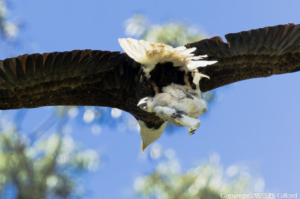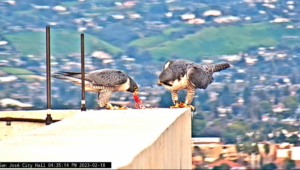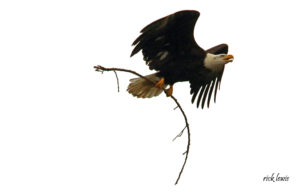Big predatory birds have been in the news this year for establishing nests in unusual human places. This spring a pair of bald eagles successfully hatched chicks in a redwood tree overlooking a Milpitas elementary school, plucking food from the city of San Jose’s nearby wastewater treatment plant. Peregrine falcons nested at the top of the UC Berkeley Campanile in April. Ospreys are living it up at the former naval shipyard on Mare Island.
It’s no fluke, says Glenn Stewart, the retired longtime director of the UC Santa Cruz Predatory Bird Group. These birds were all close to extinction 40 years ago, and now they’re back in a big way. “In 2000, the only peregrine nest that I could tell people about that existed in the Bay Area was a nest on the roof of Oracle headquarters in Redwood Shores,” he says. “Today I can name 20 public places like that. What’s going on is all these birds have recovered from the effects of DDT.”
When Stewart joined the predatory bird group, there were only two pairs of peregrine falcons in the state. Now, thanks to captive breeding, environmental regulation, and slowly receding effects from the pesticide DDT, he estimates there are more than 300. There were no bald eagles in California south of Shasta in the 1970s. Now Stewart says there are probably 40 or 50 nesting pairs in Central California alone. With such a population boom, it’s also no surprise both falcons and eagles are looking for new nesting sites, and they might have to settle for less optimal locations than their preferred cliffsides or tall trees in a forest. Stewart says he knows of two pairs of peregrine falcons that have made nests on drawbridge counterweights. They also use harbor cranes, and one enterprising pair adopted San Jose City Hall. “But the eagles in Milpitas, that really floored me,” he says. “Around such a concentration of humanity.”
But the eagles have abundant food and a tall tree. They chose the site, Stewart says, so the surroundings must be acceptable so long as no one approaches the nest. If there’s something to be concerned about, he says, it’s not the choices the birds make, but our own.
“The cautionary tale here is that 50 years ago we did the right thing,” he says. “Look around today at what’s happening. We’re talking about modifying or getting rid of many of these regulations, we’re talking about neutering the very agency that banned DDT. The question I ask is, what’s the world going to look like 50 years from now if all these regulations go down the tubes?”





